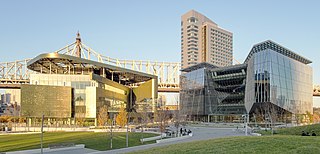Related Research Articles

Skidmore, Owings & Merrill LLP (SOM) is an American architectural, urban planning and engineering firm. It was founded in 1936 by Louis Skidmore and Nathaniel Owings in Chicago. In 1939, they were joined by engineer John Merrill. The firm opened its second office, in New York City, in 1937 and has since expanded, with additional offices in San Francisco, Los Angeles, Washington, D.C., London, Melbourne, Hong Kong, Shanghai, Seattle, and Dubai.
The Western Electric Company was an American electrical engineering and manufacturing company officially founded in 1869. A subsidiary of the American Telephone and Telegraph Company for most of its lifespan, it served as the primary equipment manufacturer, supplier, and purchasing agent for the Bell System from 1881 until 1984, when the system was dismantled. The company was responsible for many technological innovations, as well as developments in industrial management.
Westinghouse Electric Company LLC is an American nuclear power company formed in 1999 from the nuclear power division of the original Westinghouse Electric Corporation. It offers nuclear products and services to utilities internationally, including nuclear fuel, service and maintenance, instrumentation, control and design of nuclear power plants. Westinghouse's world headquarters are located in the Pittsburgh suburb of Cranberry Township, Pennsylvania. Brookfield Renewable Partners, a Canadian private equity fund and a subsidiary of Brookfield Asset Management is the majority owner of Westinghouse.

Pratt Institute is a private university with its main campus in Brooklyn, New York. It has a satellite campus in Manhattan and an extension campus in Utica, New York at the Munson-Williams-Proctor Arts Institute. The school was founded in 1887 with programs primarily in engineering, architecture, and fine arts. Comprising six schools, the institute is primarily known for its programs in architecture, graphic design, interior design, and industrial design.

Stone & Webster was an American engineering services company based in Stoughton, Massachusetts. It was founded as an electrical testing lab and consulting firm by electrical engineers Charles A. Stone and Edwin S. Webster in 1889. In the early 20th century, Stone & Webster was known for operating streetcar systems in many cities across the United States including Dallas, Houston and Seattle. The company grew to provide engineering, construction, environmental, and plant operation and maintenance services, and it has long been involved in power generation projects, starting with hydroelectric plants of the late 19th-century; and with most American nuclear power plants.

Schuyler Skaats Wheeler was an American electrical engineer and manufacturer who invented the electric fan, an electric elevator design, and the electric fire engine. He is associated with the early development of the electric motor industry, especially to do with training the blind in this industry for gainful employment. He helped develop and implement a code of ethics for electrical engineers and was associated with the electrical field in one way or another for over thirty years.

The Georgetown Steam Plant, located in the Georgetown neighborhood of Seattle, Washington, was constructed in 1906 for the Seattle Electric Company to provide power for Seattle, notably for streetcars.

Beverly Willis was an American architect who played a major role in the development of many architectural concepts and practices that influenced the design of American cities and architecture. Willis' achievements in the development of new technologies in architecture, urban planning, public policy and her leadership activities on behalf of architects are well known. Her best-known built-work is the San Francisco Ballet Building in San Francisco, California. She was a co-founder of the National Building Museum, in Washington, D.C., and founder of the Beverly Willis Architecture Foundation, a non-profit organization working to change the culture for women in the building industry through research and education.

Franklin Thompson Matthias was an American civil engineer who directed the construction of the Hanford nuclear site, a key facility of the Manhattan Project during World War II.

HLW is a full-service design firm headquartered in New York City, with offices in Madison, New Jersey; Stamford, Connecticut; Los Angeles and San Francisco, California; West Palm Beach, Florida; and London. HLW is one of the oldest continuously operating design firms in the United States.

Charles Edward Emery was an American civil engineer.

Jacques André Fouilhoux was a French-born architect active in the United States from 1904 to 1945. He is most well known for his work on Tribune Tower in Chicago; Rockefeller Center; early skyscrapers such as the Daily News Building and 30 Rockefeller Plaza; and the 1939 World's Fair in New York, for which he designed the central Trylon and Perisphere. Many of his early works are also listed in the National Historic Register, including 705 Davis Street Apartments and Wickersham Apartments in Portland, Oregon. According to the New York City Landmarks Preservation Commission, Fouilhoux has received less attention than partners such as John Mead Howells and Raymond Hood, but was "known as an astute engineer and a painstaking supervisor and his work gained the respect of his collaborators."

Hauser Dam is a hydroelectric straight gravity dam on the Missouri River about 14 miles (23 km) northeast of Helena, Montana, in the United States. The original dam, built between 1905 and 1907, failed in 1908 and caused severe flooding and damage downstream. A second dam was built on the site in 1908 and opened in 1911 and comprises the present structure. The current Hauser Dam is 700 feet (210 m) long and 80 feet (24 m) high. The reservoir formed by the dam, Hauser Lake, is 25 miles (40 km) long, has a surface area of 3,800 acres (1,500 ha), and has a storage capacity of 98,000 acre-feet (121,000,000 m3) of water when full.

The Engineering Societies' Building, also known as 25 West 39th Street, is a commercial building at 25–33 West 39th Street in the Midtown Manhattan neighborhood of New York City, United States. Located one block south of Bryant Park, it was constructed in 1907 along with the adjoining Engineers' Club. The building was designed by Herbert D. Hale, of the firm Hale & Rogers, along with Henry G. Morse, in the neo-Renaissance style. It served as the clubhouse of the United Engineering Societies, composed of its three founding societies: the American Society of Mechanical Engineers (ASME), the American Institute of Mining Engineers (AIME), and the American Institute of Electrical Engineers (AIEE). The American Society of Civil Engineers (ASCE) joined the partnership in 1917.

Artcraft Fluorescent Lighting Corporation was an American mass manufacturer of fluorescent lighting fixtures from the time of the public introduction of the fluorescent lamp at the 1939 World's Fair. Artcraft was first to announce and start mass manufacturing of a liner showcase striplight fixture and slimline ballast in 1946.

Edwin Sibley Webster was an early electrical engineer and graduate from the Massachusetts Institute of Technology. He co-founded Stone & Webster with his friend Charles A. Stone. He was president and vice-chairman of the company for many years, becoming chairman on the death of his partner in 1941.

Cornell Tech is a graduate campus and research center of Cornell University on Roosevelt Island in Manhattan, New York City. It provides courses in technology, business, and design, and includes the Jacobs Technion-Cornell Institute, a partnership between Cornell University and the Technion-Israel Institute of Technology.

Ralph Landau was a chemical engineer and entrepreneur active in the chemical and petrochemical industries. He is considered one of the top fifty foundational chemical engineers of the first half of the 20th century, and one of the 75 most distinguished contributors to chemical enterprise. He has published extensively on chemical engineering and holds a significant number of patents.

Charles A. Stone and Edwin S. Webster first met in 1884 and became close friends while studying electrical engineering at the Massachusetts Institute of Technology. In 1890, only two years after graduating, they formed the Massachusetts Electrical Engineering Company. The name was changed to Stone & Webster in 1893. Their company was one of the earliest electrical engineering consulting firms in the United States.

The Engineers' Club Building, also known as Bryant Park Place, is a residential building at 32 West 40th Street in the Midtown Manhattan neighborhood of New York City, United States. Located on the southern edge of Bryant Park, it was constructed in 1907 along with the adjoining Engineering Societies' Building. It served as the clubhouse of the Engineers' Club, a social organization formed in 1888. The building was designed by Henry D. Whitfield and Beverly S. King, of the firm Whitfield & King, in the neo-Renaissance style.
References
- 1 2 3 "C.A. Stone, Engineer, Dies at 74". Richmond Times-Dispatch . Associated Press. February 26, 1941. p. 20 – via Newspapers.com.
- ↑ "C. A. Stone Is Dead" (PDF). New York Times Obituaries. February 26, 1941. p. 21. Retrieved July 9, 2019.
- ↑ "History of Atomic Energy Collection, 1896–1991". Oregon State University Libraries. July 9, 2019. Retrieved July 9, 2019.
- ↑ "The Manhattan Project". Oregon State University Libraries. July 9, 2019. Retrieved July 9, 2019.